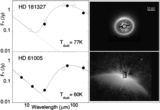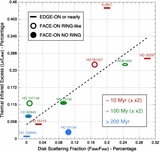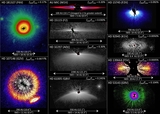Image Details

Caption: Figure 2.
Panel (A): representative STIS coronagraphic stellar PSF (WedgeA-0.6 location) showing the best fit to the ridge of pixels along one of the two sets of orthogonal diffraction spikes that "point back" to the star (the other spikes are unannotated to better show their morphology). The intersection of the two linear fits locates the star to a precision typically of ~4–5 mas for the depth of integration systematically used in individual images (differently for WedgeA-0.6 and -1.0) throughout the GO 12228 program. Panel (B): in two-wedge combined multi-roll imaging (shown here before PSF subtraction for illustrative purposes), the multiple diffraction spikes in co-aligned images allow maintaining a systematic precision in co-registration at the same 4–5 mas level. Panel (C): precise determination of the star location (green marker) enables high-precision differential astrometric measures and evaluating the significance of the measured positions of disk substructures and features with respect to the disk-hosting star, such as photocentrically determined offsets in CS debris rings (in this case for HD 181327 by elliptical isophote fitting with the best fit to the elliptical annulus of peak radial SB and corresponding minor/major axes overlaid; see Section A.1).
Copyright and Terms & Conditions
© 2014. The American Astronomical Society. All rights reserved.












